Introduction
If you’ve grown orchids for some time now, you might be pondering the idea of building a greenhouse. We all know at heart that the investment is worth it, even if it is only for 7 orchids… Love simply can’t be restrained by a single-digit number. I know it sounds crazy, but it’s not. Welcome to the orchid addiction club. Building an orchid greenhouse is an idea that crosses all our minds at some point.
To know if it’s worth the investment (or not) from a logical point of view (as if you’re trying to convince your partner who isn’t that much of an orchid fan that it’s worth the time and investment) you have to calculate how many orchids a greenhouse can hold. I suggest this argument: “..but honey, in a greenhouse of X square feet, I can grow Y number of orchids! Imagine how happy I’ll be!”
After all, how many orchids will a greenhouse hold? Warning: this is an extra-long article, so grab a drink, get a pencil and paper, and get comfortable.
I wish it was that easy of an answer and the truth is, there is no way of knowing the exact number or orchids will fit. I came across an article that suggested the maximum plant per greenhouse bench and how spacing of the plants will maximize your bench space. It was amazing… but they were not talking about orchids. That’s a whole different ball game, and I’ll explain why in this article.
In essence, after reading this, you’ll roughly know the top number (the limiting number, the maximum limit) of a stuffed greenhouse, but never use that number. Always go under that.
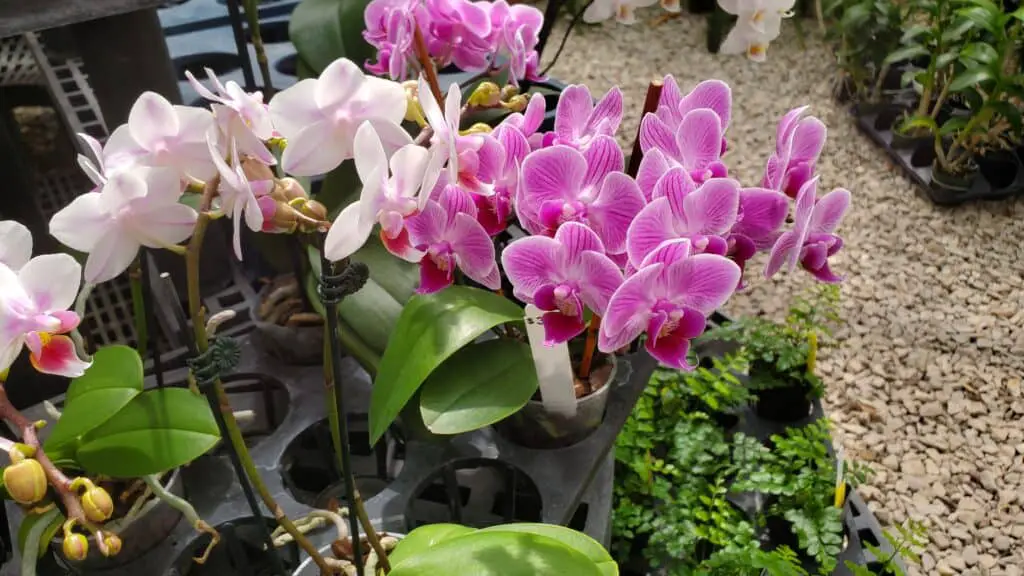
What to Calculate For Surface Area in the Greenhouse
Just so we start off on the same foot, I need to go over some orchid basics and also greenhouse basics.
- 1) How Many Orchids Can Fit into a X Square Foot Greenhouse?
- 2) How Big of a Greenhouse Do I Need to Build for X Number of Orchids?
To answer these questions truthfully, think about the placement of your orchids within the greenhouse. You can opt for single-tiered benches (which the majority of my article will focus on), two or three-tiered plant shelves, hanging plants, miniature orchids hung on tree planks, vertical ceiling space utilized for kokedamas and/or free root hanging orchids, orchid centerpieces (like on massive tree trunks) and seedling trays.
It’s almost impossible to calculate all kinds of spaces that I envision for my greenhouse. Each one of them has a different math rule, and unique considerations to be aware of when calculating the number of orchids that will fit.
Of course, we all know that with a doubt, we can squeeze in one more orchid…Each option offers a unique way to maximize the available space and create an optimal environment for your orchids to thrive.
Also, it doesn’t matter what kind of greenhouse you have, as in lean-to, free standing, or others, since available bench space is what I will be using to do all my calculations. Surface area of the space on one-tier, single level bench or greenhouse table is the one common variable in all of these equations.
I’ll try to cover those other free-flowing structures which do not sit directly on the orchid bench as best as I can in this article, but for these, the most reliable answer is trial and error. Single-layered bench space, on the other hand, is a much more reliable calculation.

Sizes of Tables or Benches for Greenhouses
When it comes to choosing greenhouse tables or benches for your orchids, there are several common types to consider. The size and orientation of the greenhouse are important factors to take into account. If you’re unsure about which type of greenhouse would be best for your orchids, I recommend checking out my other articles on greenhouses for more detailed information.
What will dictate the kind of benches you build (or buy) is how wide your greenhouse is. It all comes down to width. Funny, huh? But stay with me. If you are designing it yourself, take the width into serious consideration.
If it is at least 8 feet (2.44m) wide, then you can have two orchid tables/benches on each side (each table having a width of 30” to 36” or 0.76 to 0.91m) and a center path (60” to 66” inches (1.5 to 1.7m) down the middle. Look at this picture here:

If you greenhouse is wider than 8 feet (2.44m), then you can place a freestanding bench that will run in the middle down the long portion of your greenhouse, having a walking path on both sides. This table is usually 1.2m wide, so people can easily access it from both sides. You can also place side benches, but try not to extend them past 36 inches (0.9m), since a person can only access them from one side only. Look at this other picture:
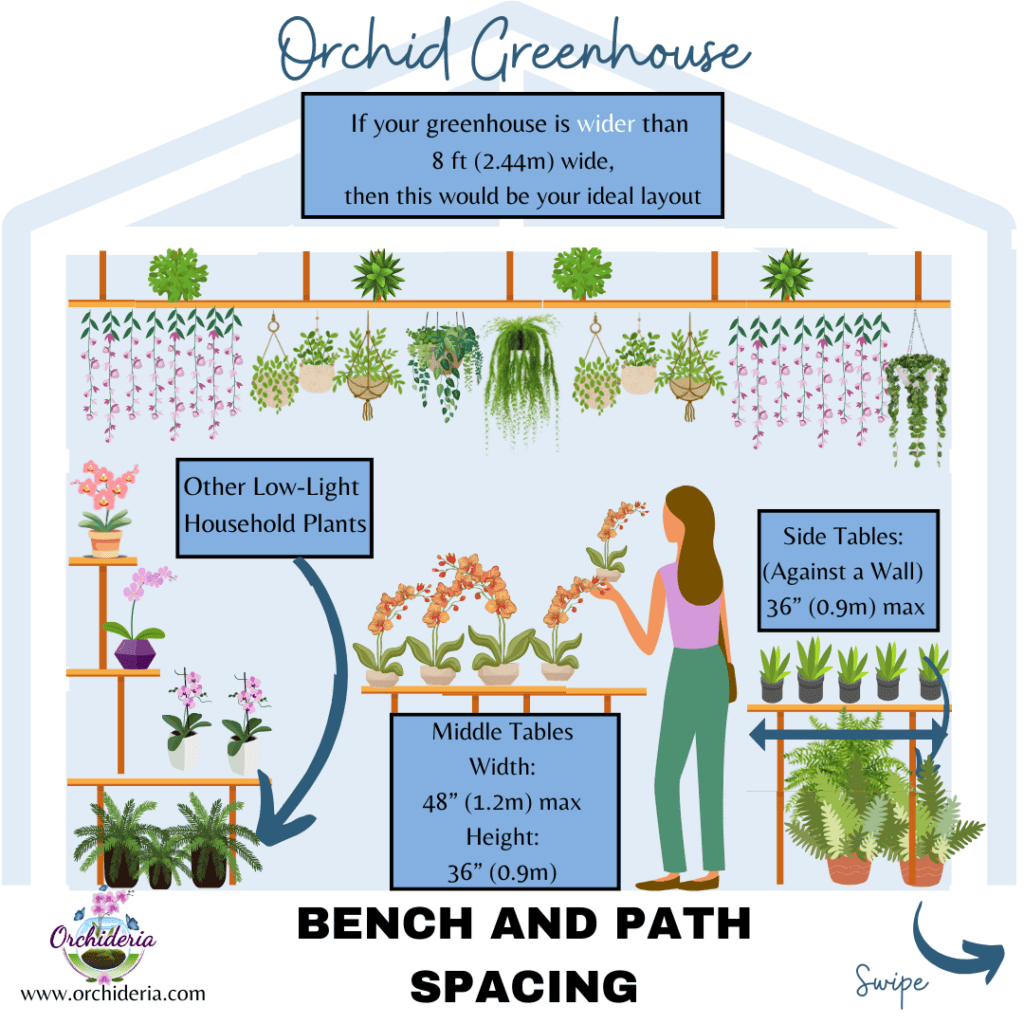
For this article, it really doesn’t matter what height the benches are, but if I don’t mention it, I’ll feel like I’ve left something out. Make the middle bench height a little lower than your waist, because they’ll be in pot, which increase the height. This means that around 30 to 36 inches (0.76 to 0.9 m) is the sweet spot. Don’t go lower or higher than that for your middle bench.
If you are building tiered levels, then add 20 inches (0.5m for each tier) and lower the same amount. This depends of how tall you are, too. If you are a bit shorter, than lower the tables.
It’s not recommended to use wood for these benches, but rather any form of material that won’t rust or rot. When you are just starting out, whatever you have will work — for now. Don’t let the wood bench stop you from going ahead with your project. This is where the base/majority of your orchids will be.
You will be growing upward from here, so your lowest-light orchids should be placed on these middle benches. The higher up on the glass walls and windows you will place the higher-light orchids. There should be no other orchids under the bench, but I don’t plan on leaving that space idle.
I’ve seen growers place dormant orchids under the bench and I hadn’t thought of that, but it sounds like a good idea as long as you don’t get water on them. I have a feeling I’ll forget about them though. Other household plants, like calla lilies, ferns, clivia, or any low-light flowering plant make the visual appeal much more pleasant and will help raise the humidity. It also doesn’t let the ground level become a muddy puddle. (I don’t plan on concreting my greenhouse floor, but his may change. Not sure…) Anyway, let me get to the point.
By considering the size, orientation, and type of greenhouse that best suits your needs, you can create an ideal environment that works for you and your orchids. Don’t set out to build something that is perfect for orchids, but will break your back trying to reach. For more in-depth information on greenhouse design and layout, be sure to check out my other articles on the topic.
- –How To Water Your Orchids in a Greenhouse

- –Building an Orchid Greenhouse: Seasonal Concerns in Winter and Summer
 ,
, - –Building an Orchid Greenhouse: Layout

- –Building an Orchid Greenhouse: Temperature
How to calculate the Pot Space (Not Pot Size)
To calculate how many pots fit on a one square foot of horizontal bench in a square pattern, first you need to find out how much space each orchid pot takes up on the bench, or Pot Space.
Before I go any further, Pot SPACE and Pot SIZE are different. Pot Space is the distance between each pot calculated from the center of orchid A to the center of the orchid B, adjacent to it. It has nothing to do with the pot size it is currently in. Keep this in mind when calculating. To make it easier to visualize, see my picture below.
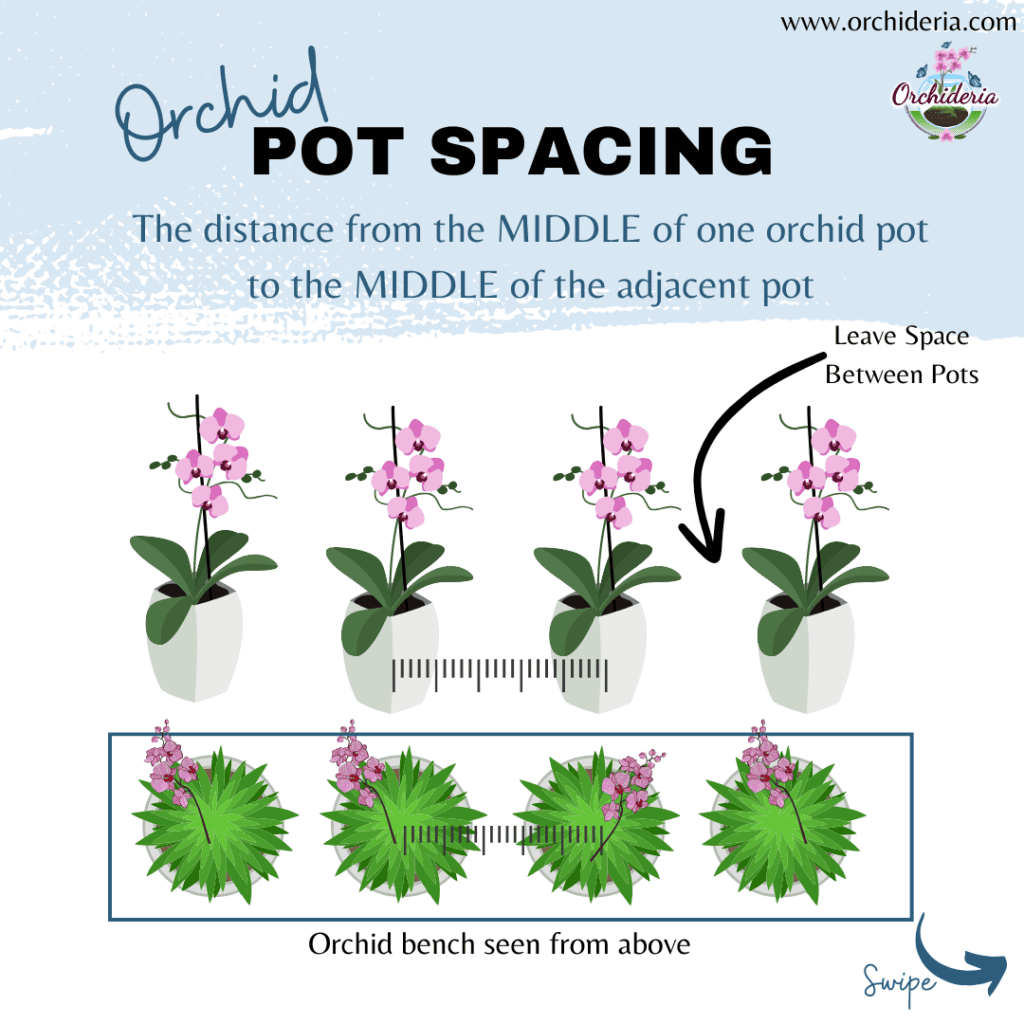
You might be asking why you need the free space around the orchid at all… Why not just use the pot size they are growing in?
Unlike household plants, orchids require more space around each pot to prevent the leaves from touching or overlapping. Another reason for the additional added space is areal roots. Phalaenopsis are horrible (or beautiful) for this trait.
You don’t want to have one orchid’s roots getting its nutrients and water in another orchid’s pot. It is a hassle to takeoff the shelf and damage will be done when watering, moving, and repotting.
This extra free space also helps minimize the risk of bacterial infections. That is the main reason we, as orchid growers, can’t just place one orchid snug up against another orchid, as other household plant cultivators do. If one orchid gets a virus, you could easily say goodbye to your whole collection. Bacterial and fungal invasions are controllable with tons of effort, but not orchid viruses.
You might be asking, “…but many greenhouse articles have pot space and perfect formulas for horticultural purposes. Why can’t I use their formula?”
You can’t rely on horticultural articles that focus on growing herbs to dictate how close your orchids can be inside the greenhouse. Their herbs will grow in the greenhouse for a span of 10 months, then they’re gone. I hope my orchids will still be thriving in full force in my greenhouse long after 10 months, and I hope that they grow both vertically and horizontally. The added space is also calculated to predict that they will grow in time, and by time, I mean years. Decades. Many decades.
Also, greenhouse horticultural growers will grow thousands of the same plant in the exact same pot size. It’s easy for them to get the geometry right and squeeze in the round pots perfectly in that rectangular bench. I speak for myself, but I don’t think any of my orchid pots are the same exact size, especially when it comes to the overhanging leaf portion. I don’t want those leaves to touch… As compared to the horticultural grower, who has 50 pots all 4-inch wide, I have 50 pots ranging from 3 inch to 18 inch wide.
Oh but the pictures…. I’ve seen so many pictures in orchid greenhouses that are jam packed with orchids, mostly in commercial grower settings and orchid expositions. The area occupied by each orchid pot (again: don’t use pot size for this) will be different for commercial growers who use plastic to envelop the leaves and force them upward (the straight and narrow path…lol). They can place orchid pots snug up to each other without risk because the plastic is separating leaves and media. This shouldn’t be the case in your greenhouse.
In orchid expositions, the orchids will remain in those spots for about a week, or much less, usually a weekend. These are showcase situations, and not over favorable growing conditions. If they were to grow like that, they would quickly become problematic.
Space is the key.
Here’s the problem. Each orchid grower will have a recommended space that they think is perfect, and that number will differ greatly from person to person.
1) Center to Center Method. This is the method that I find easiest and fastest. Determine from your orchid grower the recommended prefixed space between plants, but in the end, you will be the judge of how big your prefixed space is. The prefixed space is the measurement from the tip of the most outer leaf to the tip of the next, adjacent orchid leaf. This is your free space. You will be arranging you orchids on the bench with this prefixed space in mind.
The leaves should never touch. <— This is important.
How much space you give between them will depend on each genera but on average, I use is 3 inches. (7-8 cm) for a mature orchid. If it’s a seedling or a small orchid, then they can be pretty close, just staying in the seedling tray that I bought them on.
From the center of of orchid measure to the center of the adjacent orchid, already including the prefixed space between them. This will be your pot size, and can be used independent of how big your pots are.

2) Method #2: The Prefixed, In-between space. The most accurate but time consuming way to measure is to calculate pot by pot. It’s basically the same thing as above, but you calculate each separate segment individually.
First start with the radius of the current pot size A (radius, not diameter, because you want center to center), then add the space that your orchid leaves hang over the pot; that they protrude from the outer rim. I’ll call this the overhang space. Some small orchids will never protrude over the pot, and that’s fine. Their value is zero. You just have to be accountable for leaves that extend the pot’s rim and flow freely into the air. You don’t want them to touch the next orchid.
Then add the space between plants, (your prefixed measurement above), and now the adjacent plant’s overhang (orchid B), and half its pot diameter. In essence you are literally measuring from center to center, but it has to be done for each plant, since the overhang area is different. That will be your final pot size.
Example=Young Spathoglottis in an 6 inch pot next to another Spathoglottis of the same size. Let’s say my Spathoglottis orchid is planted in a pot size of 6-inch pot, but the showy leaves splay out to all sides, since they are quite “leafy”. Terrestrial orchid can be quite leafy, (read more about Spathoglottis here ) and my measurements came to 2 inches that the leaves stick out past the pot in all directions.
) and my measurements came to 2 inches that the leaves stick out past the pot in all directions.
Measure the radius of the pot (for my 6 inch pot that would be 3 inches), then to the end of leaves (not high, but wide) so another 2 inches of overhang , then add my the prefixed space that my orchid growers recommends (another 4 inches), the overhang of pot B (4 inches) and the radius of pot B (3 inches). 3+2+4+2+3= 14 inches is the size I need to leave for this orchid.
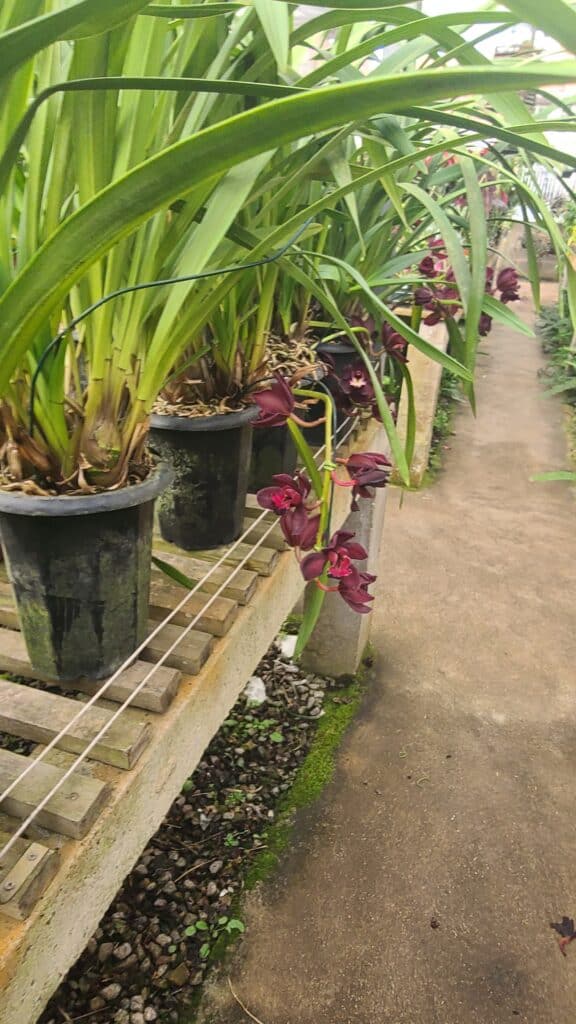
I will then consider this genera a 14-inch pot for all my Spathoglottis growing in 6 inch pot . Air flow is crucial, especially inside a glass greenhouse. Since each pot is spaced 14 inches apart, we can calculate the area by multiplying the length and width of the pot: 14 inches x 14 inches = 196 square inches. This is your orchid pot space.
Of course, this is all relative, and will vary even from plant to plant. Some orchids have leaves that are so hard and wind will not wave them into their neighbor’s area, like Cattleyas. They won’t need as much free space from their neighbors.
Spathoglottis does because their leaves a wide, thin and floppy. This is why you have to do your math considering one orchid genera on each greenhouse bench so that the math comes out right.
It is also why even doing the math, it sadly doesn’t add up in the end. Trial and error and visual cues will dictate how many orchid you can place on a bench.
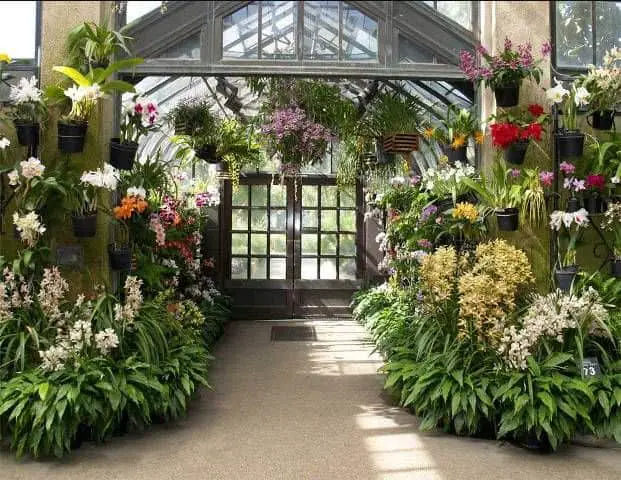
How to Calculate the Number of Orchids per Bench
The process of calculating the number of orchids that can fit onto a square foot of benches or tables involves considering three key pieces of information:
- 1) the container spacing (remember–> not the pot size), see above,
- 2) the length of the greenhouse bench
- 3) the width of the greenhouse bench
You’re probably asking why you need the exact bench measurements. You can’t simply multiply total surface area (length x width) and divide that by the pot spacing. This doesn’t work and if you’re curious as to why, I explain that in the next section.
For now, I want you to get the right way down. Your values will vary greatly depending this tad bit of new information: bench size.
For example, let’s consider a 6-ft by 10-ft bench, which equals 60 square feet, with an orchid spacing of 14 inches. (If you prefer metric, jump to the paragraph below).
First let’s see how many rows we can squeeze in. It’s a 10 foot long bench, but the pot spacing is inches. So let’s convert everything to inches first. 1 foot is equal to 12 inches. So, 10 feet is equal to 120 inches. Now, if we divide 120 inches by 14 inches (that’s our pot spacing), we get = 8.75. You can’t have 0.75 of a plant; its either on the bench or off it.
To obtain accurate results, the simple formula needs to be rounded down to the nearest whole number = 8. You can fit 8 columns of orchids on that 10 ft bench.
Now to the rows, on the 6 ft wide side. By the same math, you get 72 inches divided by 14 = 5.14 orchid pots. Discard the 0.14 and you have 5 orchid pots.
8 columns x 5 rows = In theory, I can fit only 40 orchid pots on that bench.
*For those of you who prefer to do their math in metric, I’ll give the same example above but in the metric system. Using a 1.83m × 3.05-m bench (5.57m2 of surface area) and 35.6-cm spacing on the orchid pot. Let’s start with the rows. 1.83m divided by 35.56cm = 5.14 orchid pots per row. Now for the columns. 3.05m divided by 35.56 cm gives me 8.57. You can’t have 0.14 nor 0.57 of plant, so round down to the nearest whole number. 5 rows x 8 columns = In theory, I can fit only 40 orchid pots on that bench.
It is essential to consider that a pot cannot be divided or placed on half of the bench. It also doesn’t consider that if the margin is very insignificantly over the whole number, I will squeeze that orchid pot onto the table against all of the formulas that geometry already has tested. Sorry, Pythagoras and Euclid, that orchid pot will grow on that space orchid bench. Where there is a will, there is a way.
The first question is now answered: How many 6-inch orchid pots (that use a 14-inch pot space) fit on my orchid bench that is 6 x 10 ft? 40 Orchids!!
Drawing out the layout on paper can significantly assist in visualizing the actual number of containers that can fit within the given space. By rounding down the fractional values obtained from the calculations, growers can ensure an accurate estimation of the number of orchids their bench can accommodate. Drawing out the floor plan will save other 4 orchids, otherwise having to sit outside in the cold… At least with me, drawing out the space on paper has helped tremendously. (Source )
)
Orchid Pot Spacing Doesn’t Follow the Formula
Why can’t I just calculate the surface area by multiplying the length and width of the orchid bench to get the total square footage, then divide that by the total pot spacing? This method can be misguided because of several reasons. The main one being that a plant can’t be split in half and squeezed onto the other side of the bench. The second reason is that it totally fails to see that the length and width are the limiting factors in this setup.
But there are a few other little hiccups along the way…
Let me walk you through why this most common method is wrong. I will use the same measurements I did up above to make it easier.
For example, let’s consider a 6-ft by 10-ft bench, which equals 60 square feet, with an individual orchid spacing of 14 inches. (Again, if you prefer metric, jump to the paragraph below). The pot spacing in this case, is 14 in squared = 196 inches. Divide this by 144 inches which is a square root to get 1.36 square feet per container. By dividing the total bench area (60 square feet) without any regard to how long or wide it is, by the total pot spacing area (1.36 square feet), we would expect to fit approximately 44 containers in this area.
However, this calculation is incorrect, as you see above. Now you have 4 leftover orchids that just don’t fit in without sacrificing the health of the collection.
Let me explain it a different way. Let’s look at the length of the table, 10 ft. Taking that into inches, you have 120 available inches, but the orchid pots only fill up 112 inches. The method doesn’t want you to waste those 8 inches.
The error results from assuming that the plants will occupy every square inch of space available. Therefore, the most common means for growers to estimate container numbers fitting in a given area is inaccurate.
To get the correct result, you need to round down to the nearest whole number on both length and width… Or use a drawing, like I do. I can get the math right f I make sketch it out, and visualize the patterns.
Another problem with this simple method is envisioning your workspace to fit the orchid pots beautifully, without regarding the length and width. Let’s look at this second example:
I have my orchid pot spacing for a 14-inch orchid, which I figured out above to be 196 square inches; I get 0.73 pots per square foot.
One orchid will not be able to fit in a square foot, and this is important to note down the line. This is where the calculations get messed up. Always round down to the nearest whole number to make these calculations work.
Since I can’t round down, I need to multiply by 10 to get a larger number.
To simplify the calculation, we can round it to two decimal places. Therefore, there are approximately 0.73 pots per square foot. If we want to calculate the number of pots for a larger area, such as 100 square feet, we can multiply the number of pots per square foot (0.73) by the area in square feet (100): 0.73 pots per square foot x 100 square feet =73 pots per 100 square feet.
But how are these 100 square feet arranged? Is it 5×20, 10×10, 3 x 33.3 or five smaller tables of 5×4 each? How big of a bench do I need? How many benches like this fit in my greenhouse? See where I’m going? The math could provide for a circular table, for all I know.
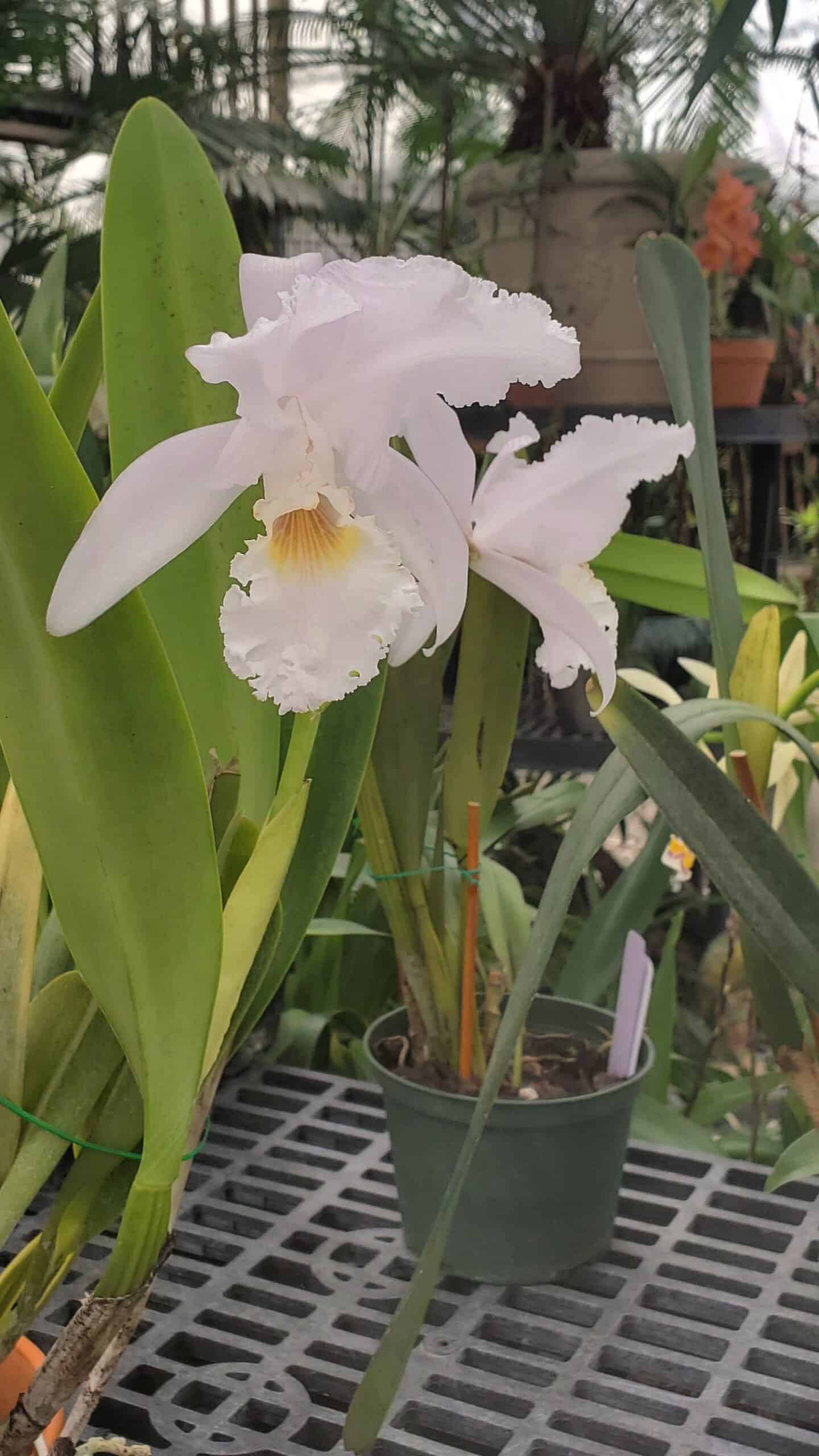
Different types of layouts for placement of the Orchid Pots
So you now have a some-what reliable method to calculate your orchid space. When you think You finally got to the end of things…. Wait, there’s more!
You may have noticed that I mentioned “by using the square layout” in the math problem above. When it comes to placing orchids on a horizontal bench, there are three main types of layouts that orchid growers can choose from: square, long staggered, and short staggered. In all the examples I listed above, I used a square pattern. Each layout has its own benefits and considerations (and formulas).
The square layout involves placing the orchid pots in parallel rows perpendicular to each other, forming squares with four containers. This layout is simple and easy to implement, making it a popular choice for many growers. It allows for efficient use of space and provides a clean and organized appearance. However, the square layout may not maximize the number of containers that can fit in a given area compared to other layouts.
On the other hand, the long staggered layout involves placing the orchid pots in rows that are offset from each other, creating a zigzag pattern. This layout allows for more containers to fit in a given area compared to the square layout. It also provides better air circulation and light penetration, which can be beneficial for the overall health and growth of the orchids.
However, the long staggered layout may require more careful planning and measurement to ensure proper spacing between the pots, especially with different sized pots. the long-staggered layout uses the length of the orchid bench as it’s guide (usually the longer side).
Similarly, the short staggered layout also involves placing the orchid pots in rows that are offset from each other, but in a shorter distance compared to the long staggered layout (used by the short side of the bench, usually the width of the table). This layout offers similar benefits as the long staggered layout, including increased container capacity and improved air circulation. However, it may require even more precise spacing and measurement to achieve optimal results. Look at this graph below:
| Pot Size | Bench Dimensions | Square Spacing | Short-Staggered | Long-Staggered |
| 4 | 4×10 | 360 | 391 | 384 |
| 4 | 6×20 | 540 | 595 | 590 |
| 6 | 4×10 | 160 | 165 | 176 |
| 6 | 6×20 | 480 | 518 | 514 |
| 10 | 4×10 | 48 | 52 | 58 |
| 10 | 6×20 | 168 | 176 | 188 |
| 12 | 4×10 | 40 | 39 | 48 |
| 12 | 6×20 | 120 | 121 | 117 |
| 12 | 6×50 | 300 | 314 | 297 |
1) Square Placement of Orchid Pots in the Greenhouse
Square placement of orchid pots in the greenhouse involves arranging the containers in parallel rows perpendicular to each other, forming squares with four containers.
This layout, based on research conducted by Will, Elizabeth, and Faust, in the research paper “Comparison of Container Placement Patterns for Maximizing Greenhouse” published in HortTechnology in 1999, provides a convenient means to calculate the number of containers that can be placed in a specified area using different placement patterns.
Its quite an old research paper, but orchid pots didn’t evolve or change shape in this time, so it’s still relevant.
According to them, ” Square spacing is frequently employed since this method is considerably easier for workers to perform accurately. Also, growers usually assume square spacing when planning for the number of containers that will fit in a greenhouse, since the calculation is relatively simple.”
The calculations for square placement is the one I mentioned before, so you already know it. I will leave a link to their article though, if you are the kind of person who enjoys math. (Source)
They made a spreadsheet you can input your information and it will tell you how many pots to place on the bench, which I found fascinating, called the Bench Space Calculator. I’ll summarize the table below for the Square Spacing in several sizes of orchid benches.
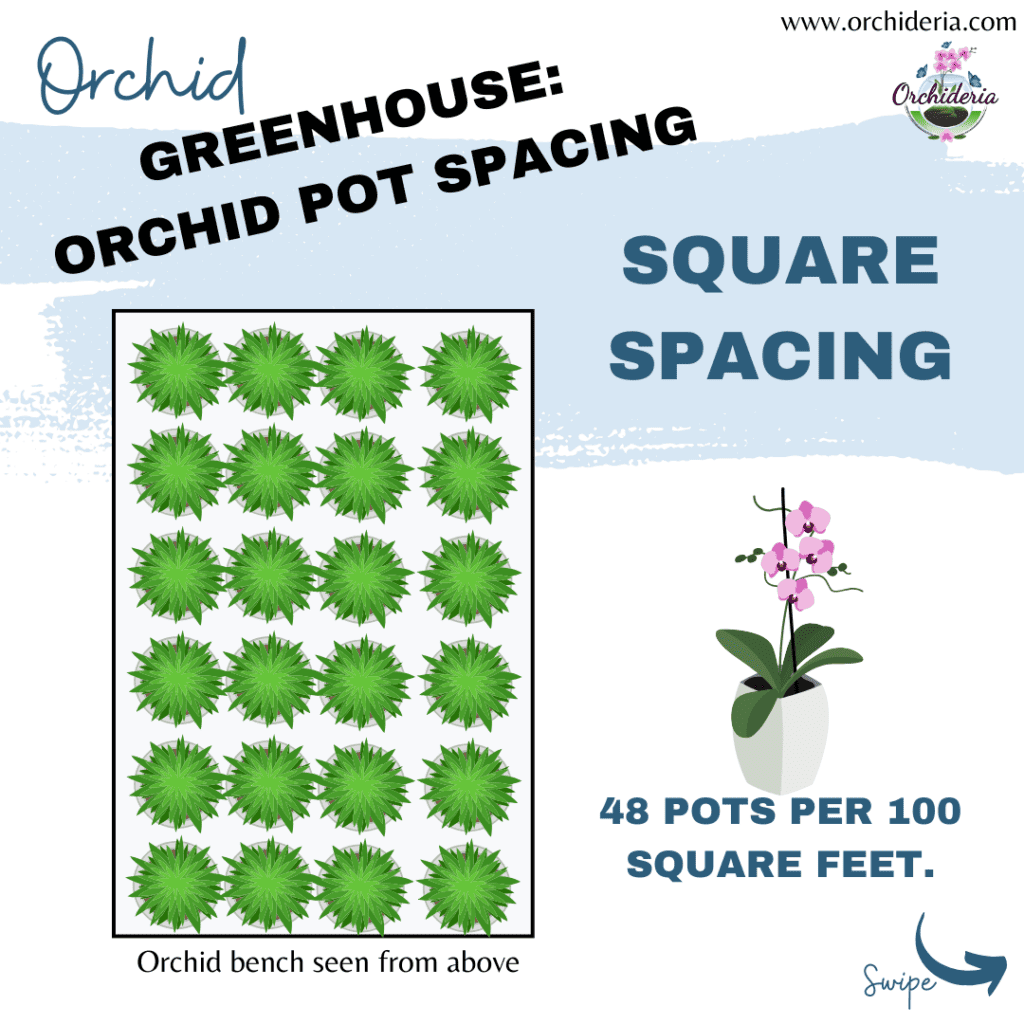
By using this calculation, you can determine how many orchid pots can fit on a one square foot of horizontal bench in a square pattern and plan to stuff your greenhouse accordingly.
2) Long Staggered and Short Staggered Layout
The long- and short-staggered patterns are other layout options for placing orchid pots in the greenhouse. These arrangements involve placing the containers in staggered arrangements, forming equilateral triangles with any three containers. Unlike the square placement, the rows of containers in the long-staggered pattern are parallel to the long dimension of the bench (usually the length). In the short-staggered pattern, the rows of containers are arranged parallel to the short dimension (usually the width) of the bench.
Both the long and short staggered arrangements on the orchid bench can allow for up to 13% more orchid pots to fit into a given area compared to square spacing. This means that by using the staggered pattern, orchid growers can maximize the number of orchid pots they can accommodate in their greenhouse. You won’t be stuffing your greenhouse beyond what is safe for the orchids.
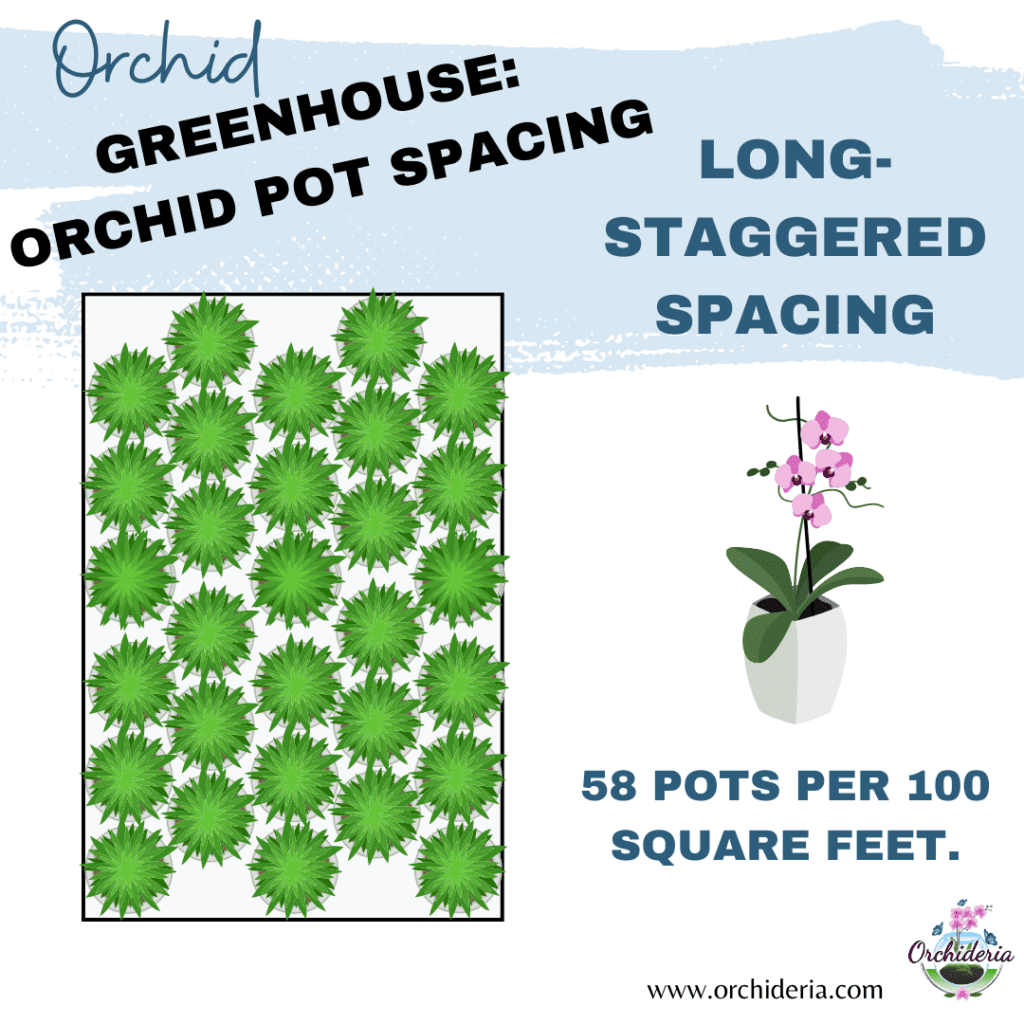

A staggered arrangement frequently allows a significant increase in the number of containers fitting in a given area, as compared to square placement. For example, the number of 6-inch (15.2 cm) containers fitting pot-to-pot in a 6 × 20-ft (1.83 × 6.10-m) area is 7.1% and 7.9% greater when arranged in long-staggered and short-staggered patterns compared to the square pattern.
In fact, the only examples in which the square spacing was more efficient than the staggered were when the containers were placed on relatively small bench or floor areas at 12-inch (30.5-cm) spacing. The advantage of a staggered compared to square arrangement frequently increases with increasing area.
Look at this table below, according to bench size, pot size, and the result in pots per bench: (insert picture)
Differences From Orchid Growers to Horticultural Growers
What if you know how many orchids you already have and want to build a greenhouse to fit them all in. I’m in the process of designing an orchid greenhouse and one of the key considerations is determining its size. “How big should I build my greenhouse to fit all my X number of orchids?”
I keep joking to myself, saying that the simple answer to the universal question of “how big”, is to build the largest greenhouse your budget can afford. I say this because, in the end, it too will become small one day. Yet, I would like to place some kind of math to my reasoning, and back it up with figures that check-out in the end.
Both questions answer have the same final intention, to grow beautiful orchids and to give them the best care, which during winter months, translates to an orchid greenhouse. Each question has a fixed variable: a) number of orchids already in your possession versus b) space that is already built.
In the previous examples, I showed how many pots I cant fit onto a one-level, single-tier orchid bench. I did this to know how many benches I need build to hold my orchids, and build my greenhouse to accommodate that number. I’m fully aware that in time these so called picture-perfect benches will all be covered in orchids, and I’ll eventually start to squeeze them into odd-shaped, uneven living conditions, but until then, I’ll keep thinking it’s going to all add up perfectly in the end. So, how many orchids can I space onto the bench?
Well… there’s not really a way to tell because of the various variables. Besides the air space in the same genus, one orchid can differ greatly in size from plant to plant. I want to keep all my Cattleyas on the same bench, but I have very new, tiny Cattleyas and 10-year old Cattleyas, that are massive. Look at the middle bench in this picture below and you’ll see where I’m going.

There are all kinds of sizes of orchids growing together and the formula doesn’t allow for that. Unless you are a commercial grower, than you won’t have 40 pots of mid-sized 3 year old Cattleyas, 40 trays of seedling Cattleyas, and another 40 pots of massive Cattleyas, and 3 separate benches to accommodate all of them.
Also, I want to arrange the orchids by bench (or shelf) with their watering needs. On the same bench, I would like to accommodate thirsty plants that love water and on a completely separate bench all the orchids that prefer to dry out a little more. That’s just the easiest for me when it comes to tending to them. Not all those orchids are in the same size pots and not all of them have the same pot spacing requirements either…
So use the formula to find how the maximum number of orchid an ideal, hypothetical greenhouse would hold, and then make sure you don’t over that number.
Tiered shelving for Orchids
So far I have been talking about the one layered, single-shelf bench for the surface area. What if the bench is tiered, as in having two or three shelves above it?
The problem with upright, vertical shelving for orchids (that other household plants don’t share) is that you don’t want orchids to be stacked on top of each other (directly overhead). The leftover water that is exiting out the bottom and side holes of your higher-tiered orchids will drip onto the plants on the bottom tier.
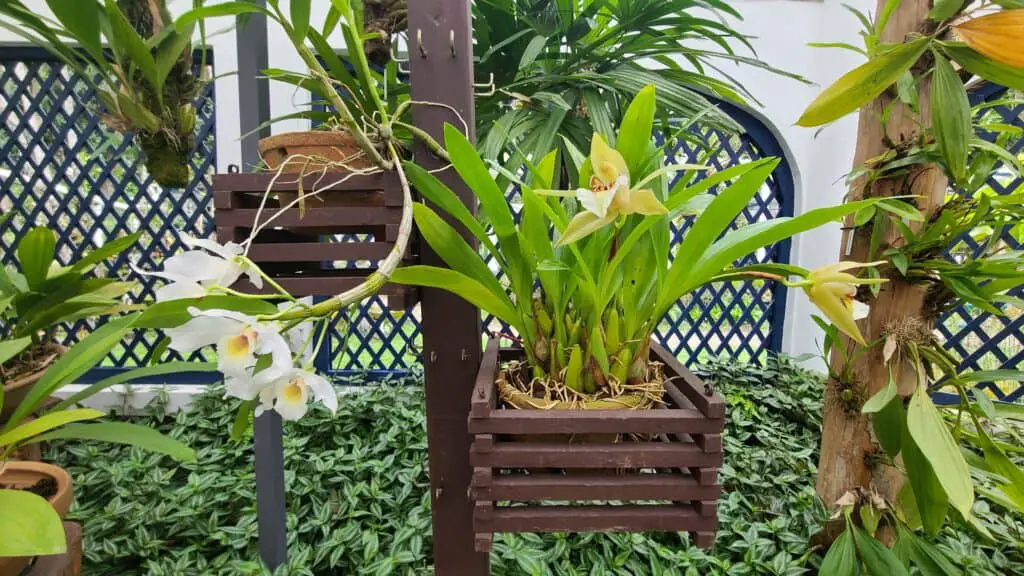
This is a great way to spread disease and multiply the bacterial problems in your greenhouse. You can tier them with horizontally above each other if you have a run-off system that prevents exiting water to reach other others, like a poly-carbonate tile angled to catch run-off an take it to the drain.
This way light can still penetrate the second tier below and water splashes will run to the drain and not onto the lower plant. This set-up involves a lot more cost, but if your greenhouse is small, it may be the perfect way to expand the space and squeeze more orchids inside.
Most all orchid benches are tiered up and out, to avoid that spillage from other orchids above them, leaving an open, blank space under the bench above. If you want to increase humidity in the area, I advise to plant water loving ferns or other low-light plants under the benches. This adds visual appeal, uses up otherwise wasted space, and the more plants in the area, the easier it is to increase humidity in that small space.
But how do you calculate for tiered planters? And whats the best system to place your tiered shelves to maximize orchid pot placement?
The bottom tier, with the lower-light orchids you will continue to use the same formulas as I mentioned above with the diagonal (or long-staggered) formula. The thinner the shelf, the less of a difference there will be between the square and the diagonal patterns. If you have a very thin shelf, you’ll find that the square accommodates more orchids, due to that rounding off to the lowest whole number. The very top tier could not use any formula at all, just be a single-file, one on one layout.
Calculating Space for Hanging Orchids
All of us who grow orchids know that we don’t only grow them in pots. We have our orchid mounts, miniature hanging orchids, and the orchid displays that hang from the gables in the greenhouse.
Stanhopeae orchids, for example, need to grow in wood baskets to allow the inflorescence to hang down, outside and under the pot. Growing them on the bench just won’t cut it. Vandas are another example of an orchid that needs it’s vertical space and it grow best being hung from the ceiling or a cable along the upper portion of the greenhouse. And there are the kokedamas, which make such cute little displays, but how do I calculate the space in the greenhouse to keep them all? How do I calculate how many vertical orchids I can grow?
What I’m really wondering is, “How in the world did I get so much orchid stuff?”
How big of a greenhouse do I need to build to fit all these wooden hanging baskets?
The vertical space for mounting orchids is not the same as the just transferring the bench space (which was horizontal) to apply the same math rules and place them now vertically. I wish that were the case, but it isn’t. To grow the orchids from mounts and find out how much space you need, you’ll need to think in terms of cylinders. To install the nails or hooks, calculate the length of the diameter of the cylinder, from center A to center B, just like before. Then add a fairly tiny free space between them. Most mounted orchids grow more vertically than horizontally.
By taking a tape measure and getting a rough idea from the tip of the largest leaf on your mound all the way to the backside of the wood plank, you will have the current circumference of the orchid mount. Be reminded though, that orchids grow. You don’t want to place a permanent nail or fixating device on the gable of your orchid greenhouse only to find out that it’s too close together, and have to pull them all out later.
Most miniature orchids will not extend the diameter of the wood they are planted on, so you can hang them up quite close to one another. Good air circulation and constant hydration is the key in keeping these healthy, so as long as those requirements are met, you don’t need to keep these too far away from each other. Make sure they are not dripping on other mounted orchid below them, so stagger the layers on the mounts below them.
Since my miniature orchids are mounted on 3 inch by 3 inch wood planks, I am going to wire up a vertical screen and nail wood rods about every 5 inches down the length. Then I can hang the orchids across the wood rod, and on the tier beneath it, staggering them out so the orchid on top is not directly above (or below) it.
As far as Vandas, I have been trying to find out how far apart to hang them, but sadly I have not come around this kind of information. I don’t have Vandas at this time since it’s too cold where I live to grow them. I will give a few sellers a call and see what they recommend. I have seen Vandas stacked one on top of each other in agglomerates, but just because a picture is amazing for that short 0.1 second of camera and lens exposure, doesn’t mean Vandas will grow like that and thrive. Picture perfect isn’t culture perfect. If you grow Vandas, please tell me in the comment section below.
Don’t Stop Learning!
If you want to be included in more information and get a 14-page fertilization guide, please sign up for my newsletter. I don’t spam, but send emails out bi-monthly with some curious topics of interest. If you want more information, click here to go to a specific page on this website where I explain it more in detail.

Also, if you are looking for an orchid journal to keep your notes specifically about orchid care, check out my 2 solutions for that on this page. If note-keeping isn’t your thing, then there is a free excel spreadsheet that you can download. Click here for more information on how to do that.
If you subscribe to my newsletter, I will send you a 14-page guide on the main tips of orchid fertilizer. It is downloadable and you can print it out on your computer. I designed the guide to double up as a coloring book, just to make it fun.
Conclusion
So, to answer your question, how many orchids can you grow in my warm-temperature greenhouse and it still be efficient for orchid care and cultivation? That will depend on your bench space and how much pot space you need for each orchid. With those two variables in mind, you can have a rough estimate of the maximum number of orchids will fit comfortably inside your greenhouse. If this article helped in any way, please share it or send it to a friend. Thank you, and Happy Cultivating!

Why can you trust anything I write? I’m not an orchid expert but I have been researching and writing exclusively about orchids for the last 5 years. All my articles are written by me, and I certainly don’t use AI to mass-produce content. I care about what I write about and what I post. I do this because I love orchid care and landscape design. Could I be wrong here and there? Yes, absolutely. The authors I’m reading and quoting could also be wrong. We are all on the road to getting better, and finding new and better ways to cultivate these amazing plants.
